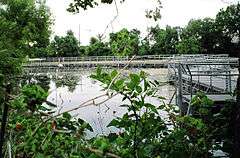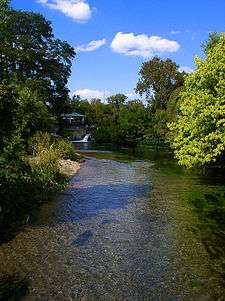San Marcos Springs
| San Marcos Springs | |
|---|---|
 The Wetlands Boardwalk encircles Spring Lake at San Marcos Springs | |
| Location | San Marcos, Texas, U.S.A. [1] |
| Coordinates | 29°53′35″N 97°55′53″W / 29.89304°N 97.93128°WCoordinates: 29°53′35″N 97°55′53″W / 29.89304°N 97.93128°W |
| Spring source | Edwards Aquifer |
| Elevation | 570 ft (174 m) above sea level |
| Type | Karst spring |
| Provides water for | San Marcos River |
| Magnitude | 1 |
| Discharge | 152 ft³/s (4300 L/s) |
San Marcos Springs is the second largest natural cluster of springs in Texas. The springs are located in the city of San Marcos, Texas, about 30 miles (48 km) southwest of Austin and 46 miles (74 km) northeast of San Antonio.
Geology


The San Marcos Springs is an area of artesian outflow from the Edwards Aquifer along the Balcones Escarpment. More than 200 springs flow from three large fissures and other smaller openings in the rock. The springs provide most of the water for the San Marcos River, which flows southward from the springs' location.
The springs have never been known to stop flowing. The average flow is 152 ft³/s (4,300 liters/s); the lowest recorded flow of 46 ft³/s (1,302 L/s) occurred in 1956.
In 1849, former Republic of Texas vice president Edward Burleson built a dam just downstream from the springs; the resulting lake, known as Spring Lake, inundated the springs.
History
Archaeologists believe that the San Marcos Springs area may be the oldest continually inhabited site in North America. Excavations at this location uncovered Paleo Indian artifacts dating back as much as 19,000 years. The Coahuiltecan refer to these springs as their origin; they called the springs Canocanayesatetlo ("warm water"), a reference to the springs' relatively warm 72 °F (22 °C) year-round temperature.
The first Europeans to see the springs were probably members of the Espinosa-Olivares-Aguirre expedition of 1709. Later, the Spanish mission San Xavier and the failed settlement of San Marcos de Neve were situated there. White Americans began settling the area in 1835, and the springs became a major stop on the Chisholm Trail. From 1928 until 1996, a resort and amusement park known as Aquarena Springs was located at the site. Texas State University-San Marcos purchased the surrounding area in 1994, and the site is now known as Aquarena Center.
Flora and fauna
This region is a dividing line for certain species occurrence. For example, the iconic California Fan Palm, Washingtonia filifera is found only west of the Balcones Fault,[2] which feature runs through San Marcos Springs.
San Marcos Springs is home to several endangered species, including the Fountain darter, the Texas Blind Salamander, the San Marcos Salamander, the San Marcos Gambusia, and Texas Wild Rice. Federal requirements to protect the species' environment, and the resulting demands those requirements place on water from the Edwards Aquifer, have led to several legal and political battles throughout the region.
References
- C. Michael Hogan. 2009. California Fan Palm: Washingtonia filifera, GlobalTwitcher.com, ed. Nicklas Stromberg
- Roy L. Lehman, Ruth O'Brien, Tammy White. 2005. Plants of the Texas Coastal Bend, Texas A&M University Press, 352 pages ISBN 1-58544-408-1, ISBN 978-1-58544-408-3
- Gregg Eckhardt. Edwards Aquifer: San Marcos Springs
Line notes
- ↑ USGS Fact Sheet 059-97
- ↑ C. Michael Hogan. 2009
External links
- Take Me To The River webcast from the Texas Parks and Wildlife Department
- San Marcos Springs from the Handbook of Texas Online
- Spring Lake Site from the Handbook of Texas Online
- Origin and Characteristics of Discharge at San Marcos Springs Based on Hydrologic and Geochemical Data (2008-10), Bexar, Comal, and Hays Counties, Texas United States Geological Survey

